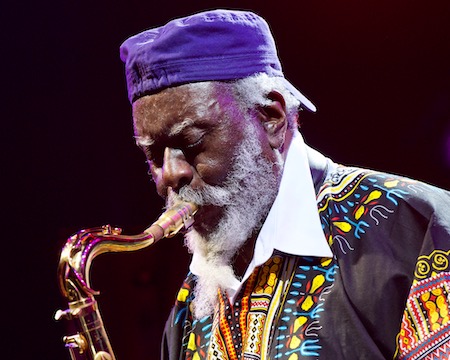Apr 2, 2024 12:59 PM
Saxophonist, Sonic Explorer Casey Benjamin Dies at 45
Casey Benjamin, the alto saxophonist, vocalist, keyboardist and producer who stamped his distinctive sounds on the…

Pharoah Sanders brought beauty and spirituality to the avant-garde forefront.
(Photo: R.I. Sutherland-Cohen)Pharoah Sanders, the saxophonist and composer who became famous for his mid-1960s work with saxophonist John Coltrane, died Saturday, Sept. 24.
The news came through a social media post from Luaka Bop Records, Sanders’ most recent record label. “We are devastated to share that Pharoah Sanders has passed away,” the statement read. “He died peacefully surrounded by loving family and friends in Los Angeles earlier this morning. Always and forever the most beautiful human being, may he rest in peace.”
Sanders was known for his searing, searching tone on the saxophone, one that pulled from blues, gospel, soul and the avant-garde to create his own personal, highly spiritual sound.
His last album, Promises, with Floating Points and the London Symphony Orchestra, was named the Beyond Album of the Year in the 2021 DownBeat Critics Poll. A newly released Coltrane recording, A Love Supreme: Live In Seattle, which features Sanders, was named Historical Album of the Year in the 2022 DownBeat Critics Poll.
“My beautiful friend passed away this morning,” said Sam Shepherd, also known as Floating Points. “I am so lucky to have known this man, and we are all blessed to have his art stay with us forever. Thank you, Pharoah”
Sanders came to fame as a member of Coltrane’s legendary band, which he played in from 1965 to 1967.
Born Farrell Sanders in Little Rock, Arkansas, on Oct. 13, 1940, he was an only child who began his musical journey playing clarinet in church. He switched to saxophone in high school and even temporarily took over teaching the band, while still a student, when his band director left the program.
He moved to Oakland upon graduation, playing clubs around town, where he became friends with Coltrane. When he moved to New York City, Sanders found life difficult and was often homeless. Legendary band leader Sun Ra took him under his wing, gave him a place to stay and encouraged him to take on the name Pharoah.
He joined Coltrane’s band in 1965, leaning into the avant-garde music of Sun Ra and others for his inspiration. He recorded on Coltrane’s Ascension and Meditations, demonstrating his hard-blowing, multiphonic techniques.
His collaborations were many and wide ranging — from Coltrane and Michael Mantler and Carla Bley’s Jazz Composer’s Orchestra Association to Don Cherry, Alice Coltrane, Kenny Garrett, McCoy Tyner, Randy Weston, Joey DeFrancesco and numerous others.
As a leader, he released more than 30 albums, many for the Impulse! label, which includes early classics like Tauhid and Karma that demonstrated the spirituality Sanders brought to his music. He carried that spirit throughout his life and career. DB

Benjamin possessed a fluid, round sound on the alto saxophone, and he was often most recognizable by the layers of electronic effects that he put onto the instrument.
Apr 2, 2024 12:59 PM
Casey Benjamin, the alto saxophonist, vocalist, keyboardist and producer who stamped his distinctive sounds on the…

“He’s constructing intelligent musical sentences that connect seamlessly, which is the most important part of linear playing,” Charles McPherson said of alto saxophonist Sonny Red.
Feb 27, 2024 1:40 PM
“I might not have felt this way 30 to 40 years ago, but I’ve reached a point where I can hear value in what people…

Albert “Tootie” Heath (1935–2024) followed in the tradition of drummer Kenny Clarke, his idol.
Apr 5, 2024 10:28 AM
Albert “Tootie” Heath, a drummer of impeccable taste and time who was the youngest of three jazz-legend brothers…

“Both of us are quite grounded in the craft, the tradition and the harmonic sense,” Rosenwinkel said of his experience playing with Allen. “Yet I felt we shared something mystical as well.”
Mar 12, 2024 11:42 AM
“There are a few musicians you hear where, as somebody once said, the molecules in the room change. Geri was one of…

Henry Threadgill performs with Zooid at Big Ears in Knoxville, Tennessee.
Apr 9, 2024 11:30 AM
Big Ears, the annual four-day music celebration that first took place in 2009 in Knoxville, Tennessee, could well be…